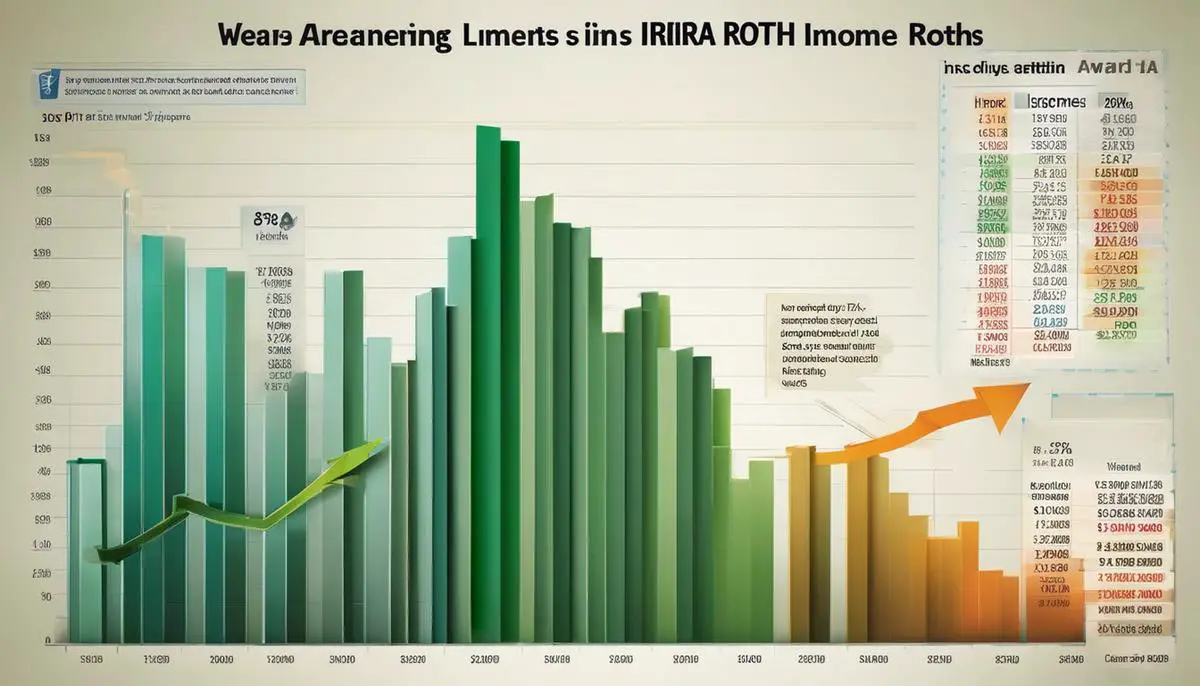Unpacking Roth IRA Income Limits 2024: Insights for Entrepreneurs
Planning for retirement in a way that optimizes your wealth and future cheerfulness may not often be a light-hearted task, considering the continuous, complex changes in tax laws and retirement strategies. One financial instrument critical to achieving this goal is the Roth Individual Retirement Account (IRA). But, understanding the basics of the Roth IRA, its associated income limits, potential changes in the year 2024, and implications on investment techniques can empower you to navigate this financial journey with more ease and confidence. This in-depth discussion will provide you with the necessary knowledge on these matters to aid your decisions.
Understanding Roth IRA
Are you ambitious about growing your wealth? Do you want to make the most of your savings for a comfortable, financially secure future? There’s a savvy financial instrument out there that you need to know about – a Roth IRA. Unpacking what a Roth IRA is and how it affects your financial planning is an essential first step to securing brighter fiscal days ahead.
A Roth IRA (Individual Retirement Account), is a retirement savings account that provides valuable tax advantages. Your contributions to a Roth IRA are made with after-tax dollars, meaning there’s no up-front tax deduction. However, the considerable advantage is that future withdrawals – upon retirement timing and age qualifications – are tax-free. This is a remarkable tool for wisely building your wealth over time.
When you consider the importance of long-term financial planning, an understanding of the Roth IRA becomes vital. Given the volatility of markets and the uncertainty surrounding future tax rates, having tax-free income during retirement can provide a significant advantage.
What sets the Roth IRA apart from other retirement saving options like the traditional IRA, is always its tax-free withdrawals. While both versions allow your savings compounding growth over time, the Roth IRA offers the reassurance of knowing exactly how much you’ll have available for your golden years – Uncle Sam won’t be taking a cut of your sacred retirement savings.
Is a Roth IRA for everyone? Not necessarily. As with all financial strategies, one size doesn’t fit all, and individual circumstances will dictate the best approach. There are certain income limitations to be aware of, and high earners may find themselves ineligible. However, for many individuals committed to long-term wealth generation, the benefits of a Roth IRA are compelling.
The Roth IRA ingeniously simplifies retirement planning and can dramatically impact your financial future. Realizing that your retirement income could be entirely tax-free opens up a world of possibilities for a financially secure sunset period of your life.
The conclusion is clear, a Roth IRA isn’t just for the financial gurus and Wall Street wizards. It’s an accessible and worthwhile tool for anyone keen to maximize their future financial stability. Taking a proactive interest in tools like Roth IRA displays a keen business perspective. Remember, smart financial planning is a defining characteristic of the savvy entrepreneur, and harnessing the power of tools such as the Roth IRA is part of that mindset. So, let’s get planning and create flourishing futures we all deserve.

Fundamentals of Roth IRA Income Limits
The Dynamics of Roth IRA Income Limits: A Deep Dive Into Your Financial Future
A Roth IRA, as we’ve established, is a powerful tool for fiscal growth and stability. Yet, in order to maximize its potential, it’s essential to understand and navigate the nuances of Roth IRA income limits. This one factor could be instrumental in shaping your retirement scenario. If overlooked or misunderstood, it can lead to underutilization of the benefits of a Roth IRA or, worse, penalties.
The concept of income limit is perhaps the most critical eligibility criterion for a Roth IRA. It essentially determines if and how much you can contribute annually. The figure is variable and correlates with factors like your filing status and Modified Adjusted Gross Income (MAGI). As of 2022, the income limit for single filers starts at $129,000, with a phase-out range between $129,000 to $144,000. For those married filing jointly, the limit starts at $204,000, with a phase-out range of $204,000 to $214,000.
But what does a phase-out range mean? As your income ascends through this range, your ability to contribute to a Roth IRA gradually decreases, eventually reaching zero once you hit the upper limit. To continue contributing, your MAGI must fall below these stated figures, pushing you to effectively manage your taxable income.
Why should you care about these income limits? Four simple words: Expanded financial planning options. By understanding and staying within these limits, you get to wield the power of tax-free withdrawals during retirement. Not to mention, distributions aren’t mandated based on age, unlike some other retirement plan alternatives.
If your income disqualifies you for a Roth IRA, fear not. The sly and savvy business persona often finds a workaround, and retirement planning is no different. Considering strategies like backdoor Roth IRA conversions or contributing to a traditional IRA first could place those Roth IRA benefits back within your grasp.
At the same time, let’s not forget the importance of diversification. Though a Roth IRA is a remarkable instrument, it shouldn’t be the solitary superhero of your retirement plan. Balancing it with other saving strategies and investments elevates your financial planning prowess, inherently offering robust backup plans and a wholesome retirement nest.
Understanding Roth IRA income limits and their implications can substantially shift the trajectory of your financial future. They are not merely arbitrary figures but strategic pillars that can help leverage this retirement tool optimally. So, remember, when it comes to retirement planning with a Roth IRA, knowledge truly is power!

Anticipated Changes to Roth IRA Income Limits in 2024
Looking ahead to 2024, several notable modifications to the Roth IRA income limits are expected. These adjustments are primarily driven by an integral aspect of the financial world – inflation. The U.S Internal Revenue Service (IRS) has always updated Roth IRA income thresholds each year to keep pace with economic fluctuations, allowing as many taxpayers as possible to take advantage of this long-term investment tool.
One anticipated change as we venture into 2024, is a possible increase in the income limits set by the IRS for Roth IRA contributions. This will potentially allow more individuals to take advantage of this tax-free growth and retirement savings tool. It’s an example of financial policymakers adjusting to a continuous stream of data reflecting economic trends and conditions—a hallmark, by the way, of a dynamic financial system that responds to the evolving needs of its stakeholders.
However, these changes are a double-edged sword. On one side, increasing the income limits means more people can contribute to their Roth IRA directly and reap the benefits it offers. On the other side, for those whose income exceeds these limitations, it could mean fewer options for direct contributions. A keener understanding of these potential changes and your place within this spectrum could translate into robust retirement planning.
The anticipation of increased income limits also opens an opportunity known as a ‘Backdoor Roth IRA.’ For the uninitiated, this is a two-step process that enables high earners, otherwise excluded due to income limitations, to pour money into a traditional IRA before converting to a Roth IRA. While this method does circumvent limits, care must be taken due to the notorious ‘Pro-rata rule’ and potential tax implications.
Furthermore, with possible changes on the horizon, strategizing becomes more complex and fruitful. If your income hovers near the anticipated phase-out range, consider contributing to a traditional IRA and converting to a Roth IRA later. Those within the bracket should contribute as much as possible, maximizing the benefits on offer.
Moreover, be on high alert, because these raises will likely wipe out income tax deductions for some high-earners, thereby narrowing their window to make tax-deductible contributions to traditional IRAs. Again, showcasing the necessity of forewarned savvy financial maneuvers.
The takeaway is this: With the anticipated changes, staying conversant in nuances like these will be critical towards gaining a competitive edge. As we forge ahead into yet another year of economic uncertainty, the ambitious individual will be empowered by their ability to pivot with these changes. And just as in business, the ability to turn challenges into opportunities in personal finance results in thriving under different economic climates and, most importantly, stability through the golden years of retirement.
In conclusion, let the upcoming alterations to Roth IRA be a prime opportunity to reorient, recalibrate and reignite your retirement savings plan. Harness this knowledge and leverage it to ensure your financial equilibrium in 2024 and beyond. Keep evolving, and keep innovating, for the only constant in finance, just like in life, is change.

Adjusting Investment Strategies to 2024 Roth IRA Income Limits
The landscape of financial planning is constantly evolving, with the 2024 Roth IRA income limit changes being yet another testament to this constant flux. As shrewd entrepreneurs and investors, it is critical to recalibrate and redefine our investment strategies in the face of such changes.
Foremost, let’s consider the anticipated increase in income limits for Roth IRA contributions. For the business-minded, this change spells opportunity. An increased income limit conjures the potential for greater direct contributions. For those who have thwarted Roth IRA contributions due to earning above the stipulated income bracket, these potential shifts could enable more direct investments into a Roth IRA, and consequently, infuse greater power into their wealth management strategies.
For high earners, the silver lining lies in the concept of a ‘Backdoor Roth IRA’. This strategy entails making a contribution to a traditional IRA and then converting that into a Roth IRA, effectively bypassing the income limit. However, it necessitates a thorough understanding not only of the process, but also of the possible tax implications. Notably, the tax on the converted amount would be due during the year of the conversion. Yet, the nuances of a ‘Backdoor Roth IRA’ offer immense strategic potential and should be considered prominently in planning for changes to income limits.
Naturally, these shifts also carry the potential to introduce complexities. For entrepreneurs, becoming conversant with these elements, in conjunction with staying informed about upcoming changes in personal finance, can set one apart on the path to financial security.
From the glasses of high earners, projected changes in the 2024 tax norms could conceivably eliminate income tax deductions. The implications of such a shift need to be considered in context, and should not spur impulsive decisions. It is prudent to make fiscal decisions with long-term goals in mind, however, acknowledging and staying abreast of these shifts is equally pertinent.
Herein lies the essence of savvy entrepreneurship. Understanding, adapting and subsequently leveraging the seismic shifts in regulations is a trademark of truly business savvy individuals. The looming Roth IRA changes offer fresh considerations, complexities but notably, opportunities in wealth management and strategic planning. Therefore, let innovation and adaptability guide financial decisions moving forward.
To put succinctly, harness the power of knowledge, redefine strategies and seize the opportunities that the changing landscape opens up. Informed, strategic action – that’s the name of the game.

While financial dynamics can seem like a maze of challenges, the information provided is designed to light your path in the haze of Roth IRA income limits and ahead-of-time predictions. How you adapt your investment strategies to the anticipated 2024 Roth IRA income limits can determine the level of financial comfort you will enjoy at retirement time. As you move forward, remember that continuous learning, proactive financial planning, and staying updated about regulations changes are your pillars to building a successful retirement plan.



Leave a Reply